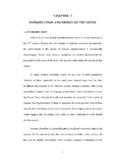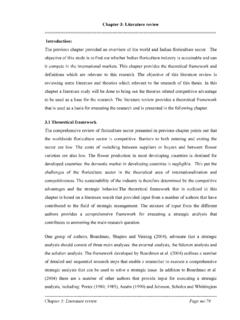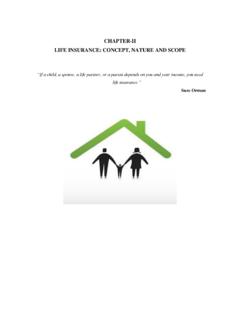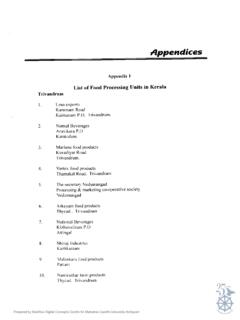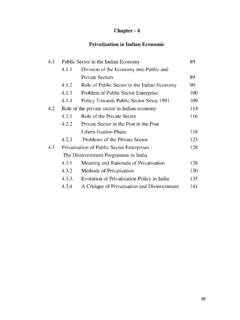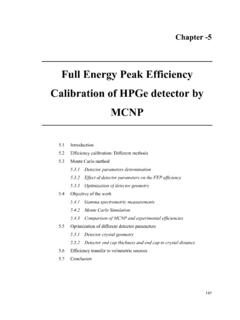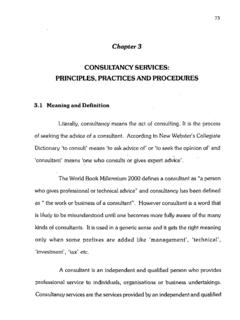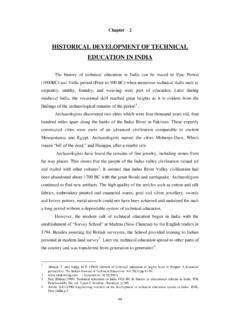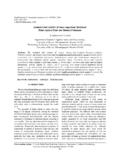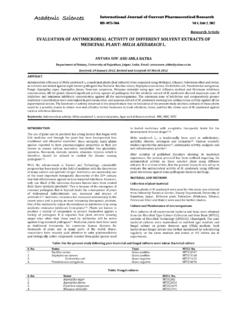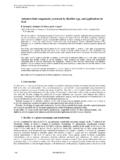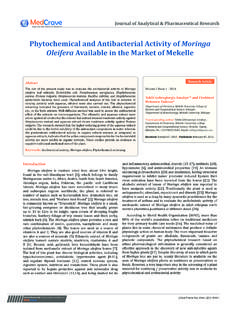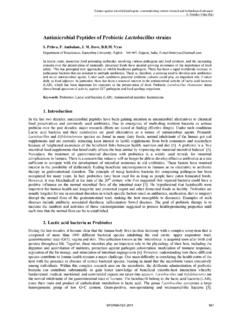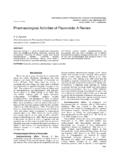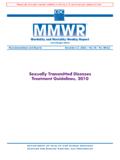Transcription of ANTIBACTERIAL ACTIVITY - Shodhganga
1 Chapter - IV: antimicrobial ACTIVITY ANTIBACTERIAL ACTIVITY . INTRODUCTION. The science dealing with the study of the prevention and treatment of diseases caused by micro-organisms is known as medical microbiology. Its sub- disciplines are virology (study of viruses), bacteriology (study of bacteria), mycology (study of fungi), phycology (study of algae) and protozoology (study of protozoa). For the treatment of diseases inhibitory chemicals employed to kill micro-organisms or prevent their growth, are called antimicrobial agents. These are classified according to their application and spectrum of ACTIVITY , as germicides that kill micro-organisms, whereas micro-biostatic agents inhibit the growth of pathogens and enable the leucocytes and other defense mechanism of the host to cope up with static invaders.
2 The germicides may exhibit selective toxicity depending on their spectrum of ACTIVITY . They may act as viricides (killing viruses), bacteriocides (killing bacteria), algicides (killing algae) or fungicides (killing fungi). The beginning of modern chemotherapy has largely been due to the efforts of Dr. Paul Ehrlich (1910), who used salvarsan, as arsenic derivative effective against syphilis. Paul Ehrlich used the term chemotherapy for curing the infectious disease without injury to the host's tissue, known as chemotherapeutic agents such as ANTIBACTERIAL , antiprotosoal, antiviral, antineoplastic, antitubercular and antifungal agents.
3 Later on, Domagk (1953) prepared an important chemotherapeutic agent sulfanilamide. CLASSIFICATION OF ANTIBACTERIAL AGENTS. The ANTIBACTERIAL agents are classified in three categories: 197. Chapter - IV: antimicrobial ACTIVITY (I) Antibiotics and chemically synthesized chemotherapeutic agents. (II) Non-antibiotic chemotherapeutic agents (Disinfectants, antiseptics and preservatives). (III) Immunological products. (I) Antibiotics They are produced by micro-organisms or they might be fully or partly prepared by chemical synthesis. They inhibit the growth of micro-organisms in minimal concentrations.
4 Antibiotics may be of microbial origin or purely synthetic or They can be classified by manner of biosynthesis or chemical structure. Structurally, they are classified into different classes as shown in the following table. CLASSIFICATION OF ANTIBIOTICS ACCORDING TO THEIR CHEMICAL. STRUCTURE (Berdy, 1974)2. No. Name of the group Example 1. Carbohydrate-containing antibiotics Pure sugars Nojirimycin Aminoglycosides Streptomycin Orthosymycins Everninomicin N-Glycosides Streptothricin C-Glycosides Vancomycin Glycolipids Moenomycin 2. Macrocyclic lactones Macrolide antibiotics Erythromycin Polyene antibiotics Candicidin 198.
5 Chapter - IV: antimicrobial ACTIVITY Ausamycins Rifamycin Macrotetrolides Tetranactin 3. Quinones and related antibiotics Tetracyclines Tetracycline Anthracyclines Adriamycin Naphthoquinones Actinorhodin Benzoquinones Mitomycin 4. Amino acid and peptide antibiotics Amino acid derivatives Cycloserine -Lactum antibiotics Penicillin Peptide antibiotics Bacteriacin Chromopeptides Actinomycins Depsipeptides Valinomycin Chelate forming peptides Bleomycins 5. Heterocyclic antibiotics containing oxygen Monensin Polyether antibiotics 6. Heterocyclic antibiotics containing nitrogen Polyoxins Nucleoside antibiotics 7.
6 Aromatic antibiotics Cycloalkane derivatives Cycloheximide Steriod antibiotics Fusidic acid 8. Aromatic antibiotics Benzene derivatives Chloramphenicol Condensed aromatic antibiotics Griseofulvin Aromatic ether Novobiocin 9. Aliphatic antibiotics Compounds containing phosphorous Fosfomycins 199. Chapter - IV: antimicrobial ACTIVITY Synthetic antimicrobial agents include sulfonamides, diamino pyrimidine derivatives, antitubercular compounds, nitrofuran compounds, 4-quinoline antibacterials, imidazole derivatives, flucytosine etc. (II) Non-antibiotics The second category of ANTIBACTERIAL agents includes non-antibiotic chemotherapeutic agents which are as follows: 1) Acids and their derivatives Some organic acids such as sorbic, benzoic, lactic and propionic acids are used for preserving food and pharmaceuticals.
7 Salicyclic acid has strong antiseptic and germicidal properties as it is a carboxylated phenol. The presence of COOH. group appears to enhance the antiseptic property and to decrease the destructive effect. Benzoic acid is used externally as an antiseptic and is employed in lotion and ointment. Benzoic acid and salicylic acid are used to control fungi that cause disease such as athlete's foot. Benzoic acid and sodium benzoate are used as antifungal preservatives. Mandolic acid possesses good bacteriostatic and bactericidal properties. 2) Alcohols and related compounds They are bactericidal and fungicidal, but are not effective against endospores and some viruses.
8 Various alcohols and their derivatives have been used as antiseptics ethanol and propanol. The ANTIBACTERIAL value of straight chain alcohols increases with an increase in the molecular weight and beyond C 8- the ACTIVITY begins to fall off. The isomeric alcohol shows a drop in ACTIVITY from primary, secondary to tertiary. Ethanol has extremely numerous uses in pharmacy. 200. Chapter - IV: antimicrobial ACTIVITY 3) Chlorination and compound containing chlorine Chlorination is extensively used to disinfect drinking water, swimming pools and for the treatment of effluent from industries.
9 Robert Koch in 1981 first referred to the bactericidal properties of hypochlorites. N-chloro compounds are represented by amides, imides and amidines wherein one or more hydrogen atoms are replaced by chlorine. 4) Iodine containing compounds Iodine containing compounds are widely used as antiseptic, fungicide and amoebicide. Iodophores are used as disinfectants and antiseptics. The soaps used for surgical scrubs often contain iodophores. 5) Heavy metals Heavy metals such as silver, copper, mercury and zinc have antimicrobial properties and are used in disinfectant and antiseptic formulations.
10 Mercurochrome and merthiolate are applied to skin after minor wounds. Zinc is used in antifungal antiseptics. Copper sulfate is used as algicides. 6) Oxidising agents Their value as antiseptics depends on the liberation of oxygen and all are organic compounds. 7) Dyes Organic dyes have been extensively used as ANTIBACTERIAL agents. Their medical significance was first recognized by Churchman 3 in 1912. He reported inhibitory effect of Crystal violet on Gram-positive organism. The acridines exert bactericidal and bacteriostatic action against both Gram-positive and Gram- negative organisms.

